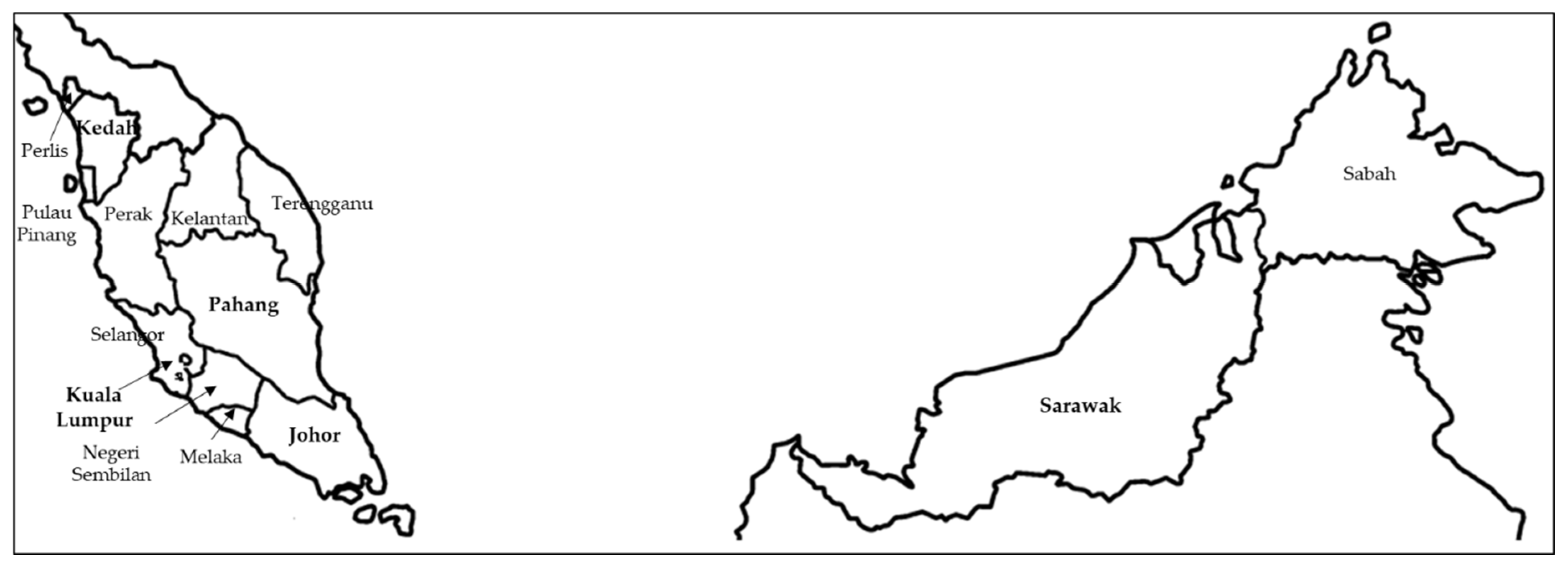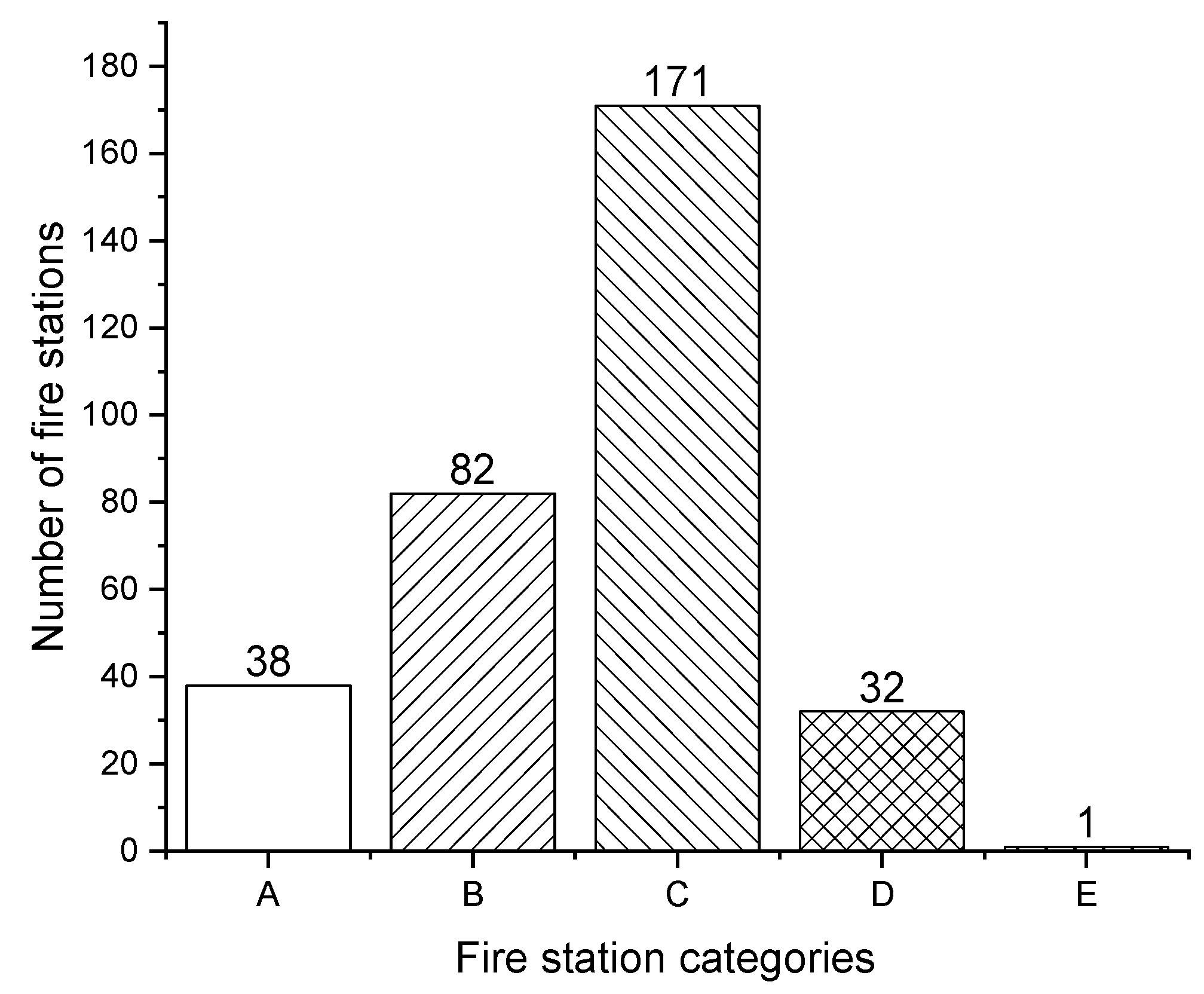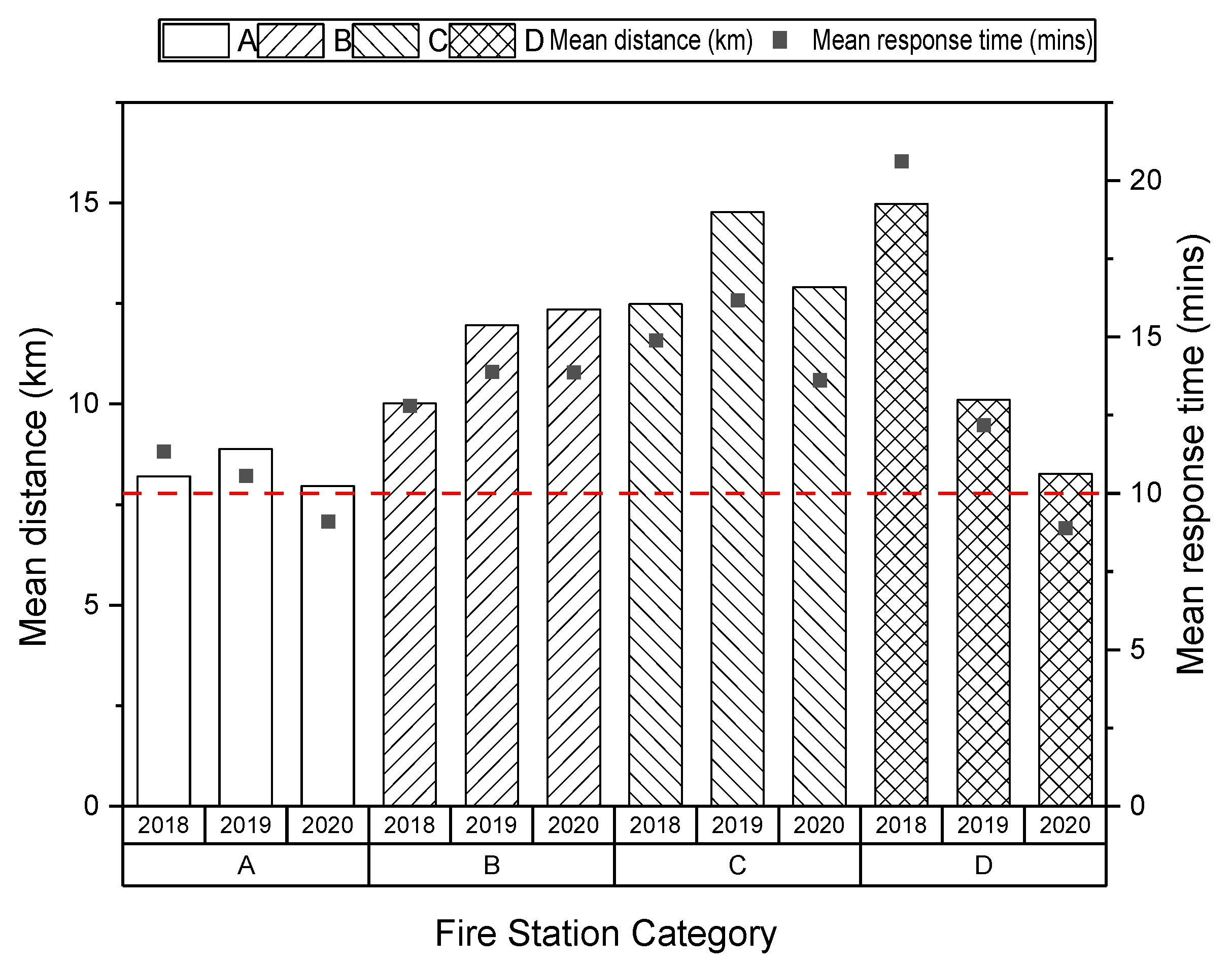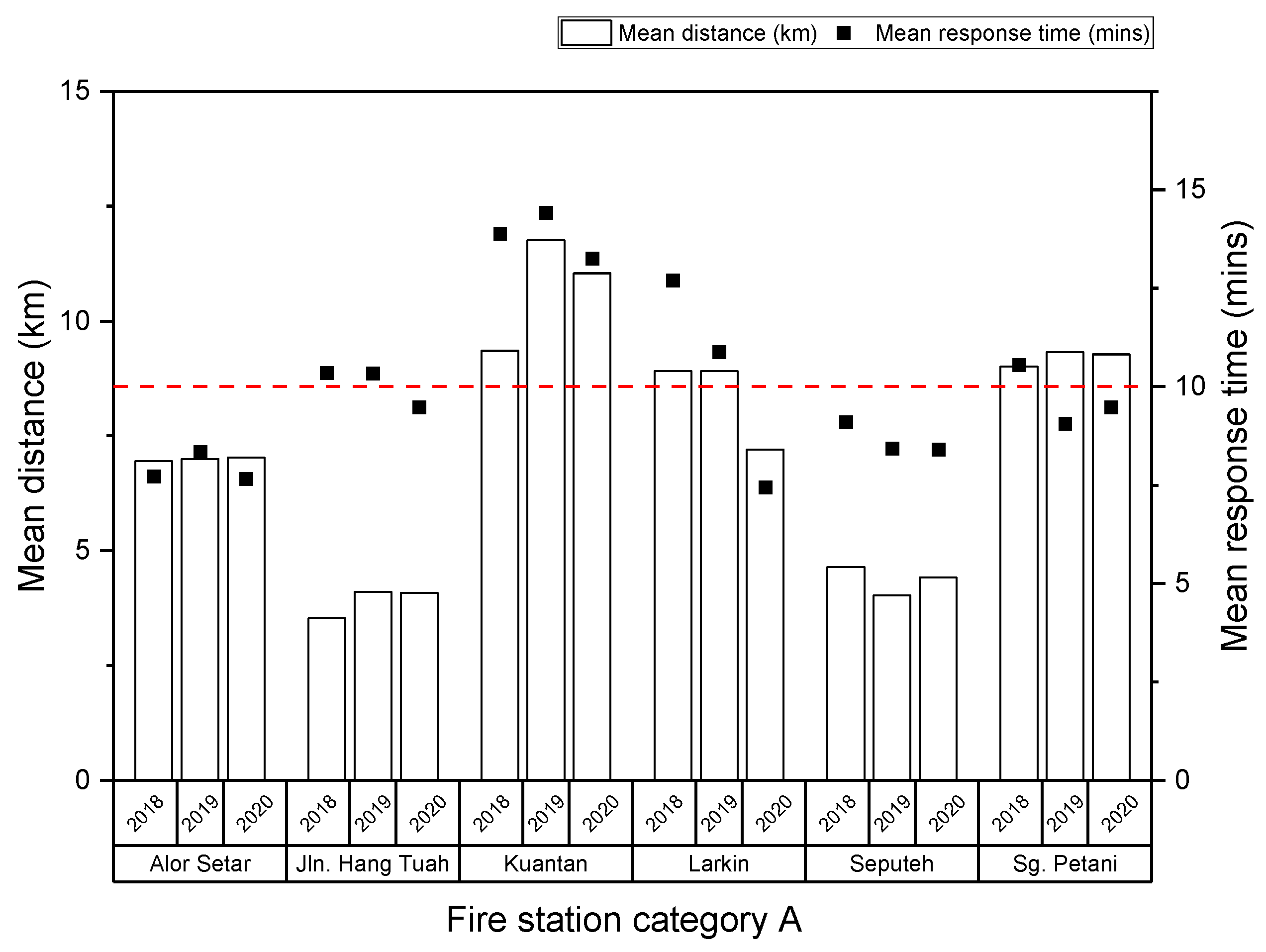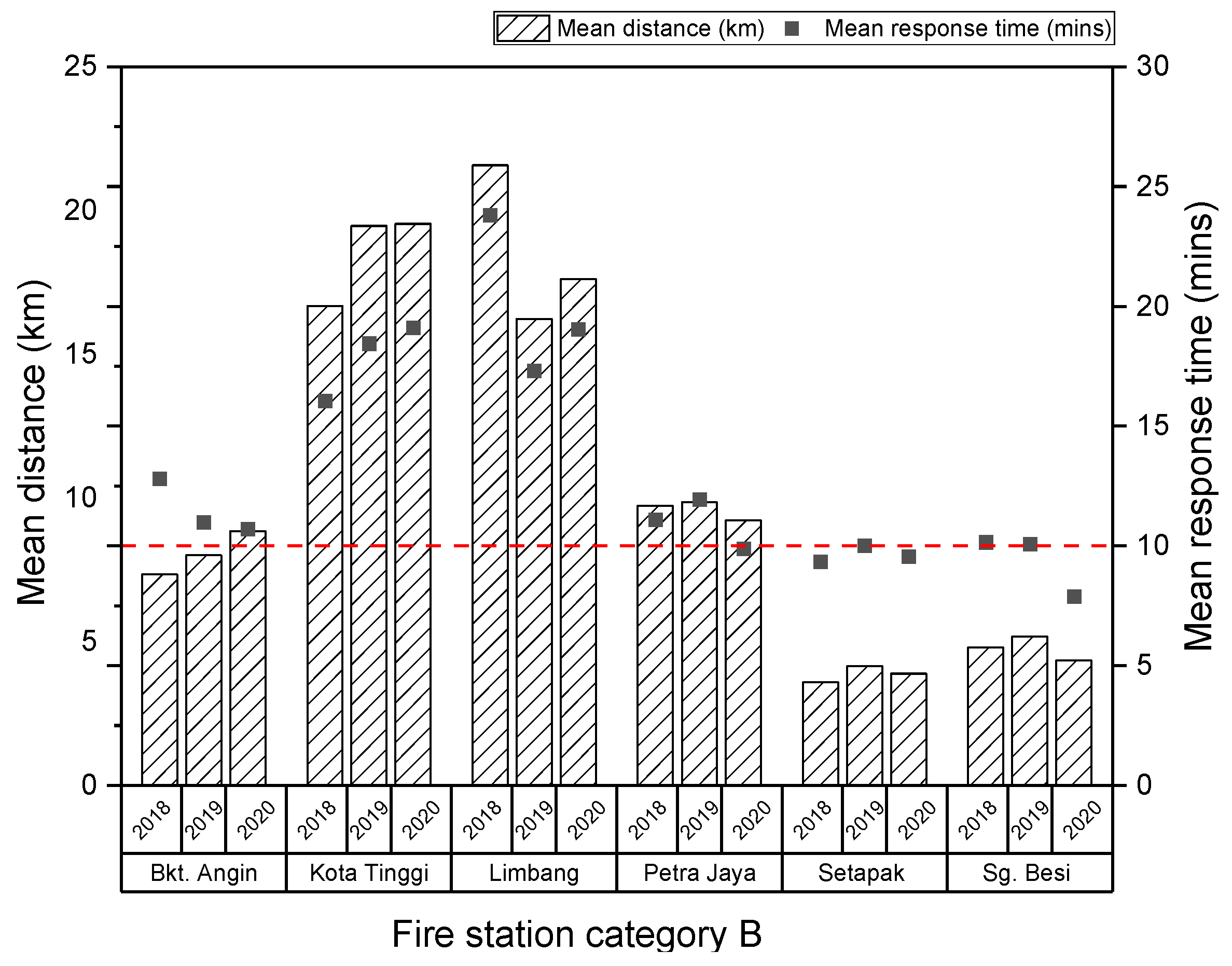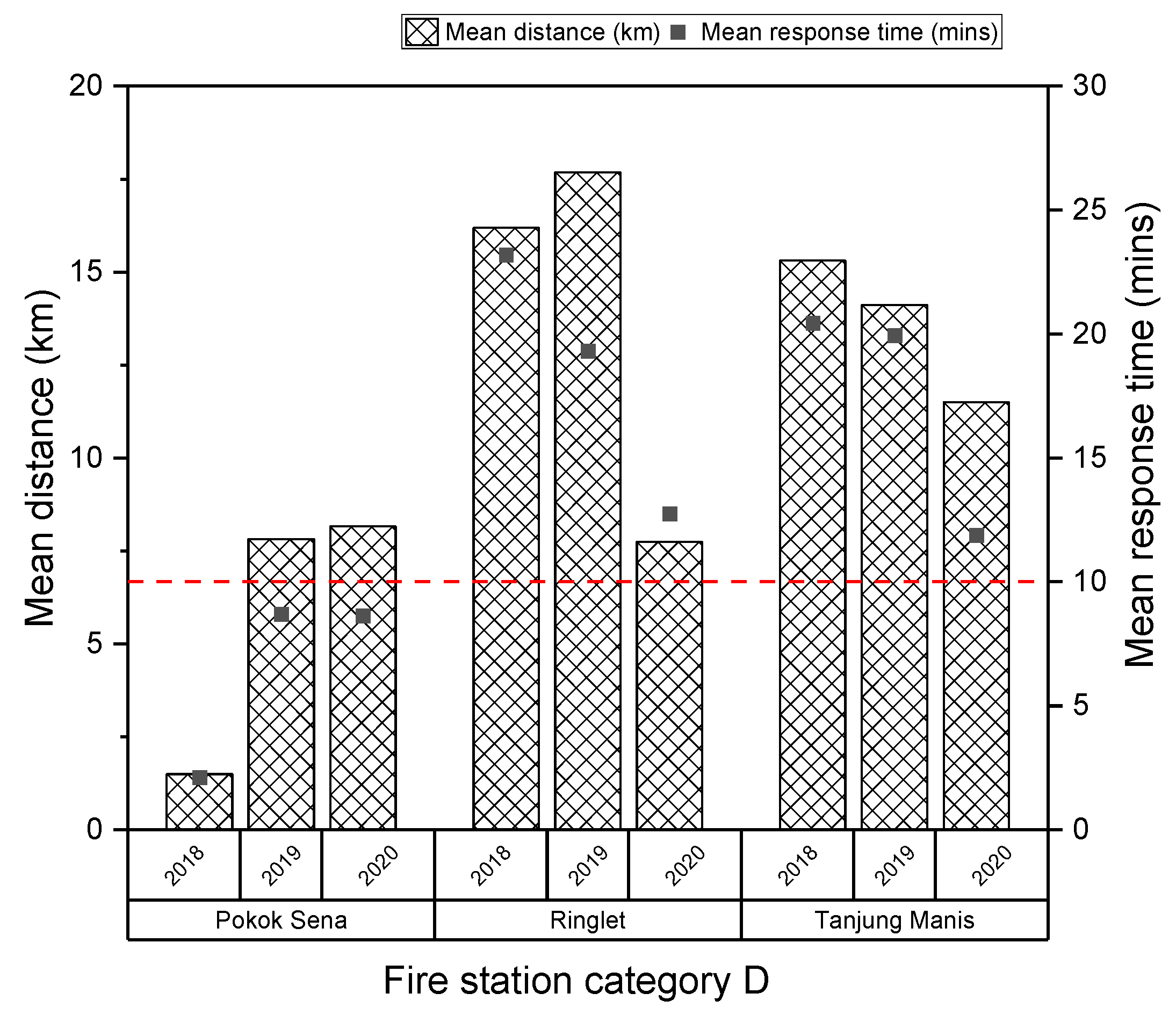3.1. Data Description
Currently, there are 324 fire stations in Malaysia. These are categorized as A, B, C, D, and E. Nationwide, 52.8% of fire stations (n = 171) fall into category C, indicating moderate fire risk locations; 25.3% (n = 82) are in category B, indicating high-risk locations; and 11.7% (38) are in category A, for very high-risk areas. Category E fire stations were excluded from this study as the category encompasses only 1 fire station.
Risk profiling scores were calculated based on criteria such as population size, industry size, and type of residence. A risk profiling score > 35 points for category A fire station locations refers to urban areas or high-risk industrial properties, while a score of 19–27 points for category C fire station locations refers to smaller cities with large construction areas, such as multi-story residences. The Malaysian demographic is primarily classified under category C.
The current risk profile used by FRDM might be different to risk profiling used in the United States, where only the number of population per mile is considered [
14], while British Standard Institution Published Document 7974-5 [
15] only takes into account main shopping malls and business center, movie theaters, and other entertainment centers or high-risk industrial properties for category A.
Figure 2 illustrates the distribution of fire stations in Malaysia according to category.
The facilities and equipment for each station quantify the degree of potential fire hazard according to the risk profile score. Category A fire stations are well-equipped with fire rescue tenders (FRTs), water tankers (WTs), emergency medical rescue service (EMRS), and special vehicles such as aerial ladder platforms (ALPs). By contrast, fire stations in the other categories receive less equipment and resources. For example, only FRTs and WTs are available to category C stations.
3.3. Variation in Mean Response Time from 2018 to 2020
This section describes a benchmarking exercise on mean response time from 2018 to 2020 by the selected fire stations. It is not a definitive conclusion of the level of service rendered by FRDM. The data reported are used as a reference for identifying the trends and correlating issues that require further attention. The mean 10 min response time (red line) depicted in the following figures is a national mean response time benchmark.
Figure 4 shows that most of the selected fire stations recorded a mean response time of >10 min in 2018–2020. It is worth noting that the mean response time for category A, C, and D fire stations improved, while category B fire stations maintained the same mean time of 14 min. In 2020, category A and D fire stations met the 10 min standard response time with times of 7.9 and 8.9 min, respectively. The MCO reduced traffic density significantly, which helped in improving the delay for rescue teams arriving at fire incidents as compared to 2019, as supported by Chen et al. [
17]. According to studies conducted by Challands [
18], quick response time does result in fewer casualties in most incidents. The studies reported that between 4 and 7 min, the response time and the level of casualties are in a positive relationship comprising 63% of occurrences and 69% of casualties.
The shorter mean distance travelled for category D fire stations could be an important factor in the significant reduction in response time in 2020. Yung [
19] and Tómasson et al. [
20] reported that one of the main factors influencing response time is the distance travelled, with average speeds of approximately 20 km/h for short distances in city centers reported compared to 70 km/h for longer distances on state highways.
This main factor was validated by Pearson’s correlation between response time and distance travelled based on fire station category.
Table 2 shows that there is a strong positive correlation between response time and distance travelled for category B, C, and D fire stations, with values between 0.5 and 1. The highest Pearson correlation value was for category B, with 0.89, followed by categories D and C, with 0.86 and 0.76, respectively. The positive values indicate that response time can increase with distance. Category A fire stations recorded a medium positive correlation (0.39), with
p-value < 0.5.
Table 3 gives a summary of ANOVA results for mean distance travelled and Tukey’s post hoc honestly significant difference (HSD) test for overall mean distance travelled for 2018–2020. The ANOVA result was significant (F (3, 10229) = 250.72 (
p-value = 0.00)). As the
p-value was <0.05,
can be rejected, meaning that distance travelled was statistically significantly different between station categories. This implies that a different mean distance travelled applies between station category.
The multiple comparison tests of mean values were significant (p-value < 0.05). The results indicate that the paired categories recorded significantly different mean distances travelled. The homogeneous subset demonstrated that category C fire stations travelled the greatest distance (13.6 km), followed by category B (11.5 km), D (9.7 km), and A (8.4 km). As the ANOVA results were significant, Tukey’s post hoc HSD test was performed to compare the means between the two categories.
Table 4 provides a summary of ANOVA results for the mean response time and Tukey’s post hoc HSD test. Categories A and D recorded slightly different mean response times while the other paired comparisons showed significantly different values. The homogeneous subset shows that category A fire stations recorded the shortest response time (10.3 min), followed by category D and B fire stations. Category C fire stations recorded the longest mean response time (15.1 min) and did not meet the maximum response time threshold.
Figure 5 shows the mean distance travelled and response times of category A fire stations. The highest values were recorded for the fire station in Kuantan, a city on the Peninsular Malaysia east coast. East coast cities are moderately less dense than cities in western or southern Peninsular Malaysia. In 2019, Kuantan firefighters travelled a mean 11.8 km to fire incident locations. Meanwhile, from 2018 to 2020, the Kuantan fire station recorded a mean distance travelled of 10.7 km with a mean response time of 13.9 min. The Larkin fire station recorded an improved mean response time each year, with a response time of 7.5 min in 2020. The reduced traffic in 2020 may be one of the primary factors in the better response time for category A fire stations.
As the ANOVA indicated a significant difference between the stations (F (5, 5676) = 40.22 (
p-value = 0.00)), Tukey’s post hoc HSD test, summarized in
Table 5, indicated no difference between the mean response times of the six paired stations. The homogeneous subset for overall mean response time demonstrated that the Alor Setar and Seputeh fire stations met the standard response time; both of them also met the standard response time every year. The Jalan Hang Tuah fire station recorded a low mean distance travelled of 3.9 km. Nevertheless, the high traffic flow and dense population, with businesses located in the area, led to response times in 2018 and 2019 exceeding the standard.
The long response time of the Kuantan fire station might be due to its larger coverage area, as the overall mean distance travelled was 10.9 km. The population and industry in this area are distributed quite distant from each other. A New York study reported that travel time increased linearly with the square root of the distance travelled for short distances and proportionally with the distance travelled for long distances [
21].
Figure 6 shows that in category B, the Kota Tinggi and Limbang fire stations recorded the highest mean distance travelled and response times from 2018 to 2020, with values of 18.6 km and 17.9 min and 18.5 km and 20.0 min, respectively. These two fire stations also recorded a slight increment in mean response time in 2019 and 2020. The Setapak and Sungai Besi fire stations recorded consistent mean response times. These two stations experience slower traffic movement during peak hours (to and from the office).
ANOVA revealed that there was a significant difference (F (5, 5676) = 48.15 (
p-value = 0.00)) between the stations. However, the multiple comparison test in
Table 6 yielded no difference between mean response times for the seven pairs of fire stations. The homogeneous subset for overall mean response time divided the stations into two groups. The Sungai Besi, Setapak, Petra Jaya, and Bukit Angin fire stations are in group 1, which means that their response times were within the same range. A major factor in the short mean response time for group 1 is a well-developed road network. Unlike group 1, the group 2 fire stations (Kota Tinggi and Limbang) recorded long mean response times due to geographical limitations. Both of these fire stations may be located in less dense areas, but the road network infrastructure is not as well developed as in group 1. Furthermore, Limbang does not have a road connection with the rest of the Sarawak road network. Aside from the large coverage area of this fire station, this could be a factor for the long distance travelled.
Category C is the largest category of Malaysian fire stations.
Figure 7 shows that all fire stations except for Kulim did not meet the standard response times in 2019 and 2020. This category recorded the mean response time, at 15.1 min, and distance travelled, 20.1 km. Kulim is a district in Kedah, a northern Peninsular Malaysian state known for its growing industrial area. Kulim firefighters travelled a mean distance of only 8.6 km for three years compared to the 20.1 km by Kanowit firefighters. Kanowit is a Sarawak district with a less dense population and less development than other areas. This may contribute to the larger coverage of Kanowit fire station compared to other areas. The Taman Tas, Yong Peng, and Pekan Nenas fire stations recorded mean distance travelled of <17 km and decreased mean response time in 2020. The reduced traffic density during the MCO may be the main reason for the shorter response times.
The ANOVA of category C fire stations indicated a significant difference (F (5, 5676) = 68.69 (
p-value = 0.00)) between the stations. Tukey’s post hoc HSD test (
Table 7) indicated no difference in mean response time between two paired stations in multiple comparison tests. The homogeneous subset for overall mean response time demonstrated that the Kulim fire station recorded the lowest mean response time (9.2 min), followed by the Pekan Nenas (14.5 min), Taman Tas (17.3 min), Yong Peng (18.2 min), and Kanowit (22.3 min) fire stations.
The areas in which category C fire stations are located are considered developing towns with small-scale industries. These areas were previously rural, with an agricultural economy, and are now shifting to an industrial economy, especially the town of Kulim. The transportation system and residential layout may be affected by the growing demands of the population, which directly influences the response time of rescue teams. The non-uniform speed of vehicles travelling to locations due to poor road design and surface may also explain the longest mean response time for this category.
According to Yang et al. [
22], the expansion of the demographic structure has heightened the need for fire services. Previous risk assessment data may no longer be valid. In this situation, a strategic plan is required to establish new fire stations in order to meet the demand in the area.
The areas in which category D fire stations are located are considered semi-rural. The low density of these areas results in fire stations servicing a greater coverage area, as illustrated in
Figure 8 for the Ringlet and Tanjung Manis fire stations. Both fire stations recorded a mean distance travelled of approximately 13.8 km with a mean response time of 17.9 min.
Fire stations in this category do not have the Lite CAD system to capture emergency calls. Instead, emergency calls are transferred by the State Operations Management Center to the fire station control room, creating a delay in response time.
In this category, fire incidents can occur in isolated areas, resulting in longer response times. For example, 30% of the Tanjung Manis area is accessible only by water transport, requiring additional response time. Ringlet is a highland area in Peninsular Malaysia with small perimeter roads and many slow-point lanes. Maneuvering in this landscape is quite challenging for rescue teams, which increases their travel time. Fire engines require unobstructed access roads at least 6 m wide.
The ANOVA of category D indicated a significant difference between the stations (F (5, 5676) = 38.24 (
p-value = 0.00)). Tukey’s post hoc HSD test (
Table 8) revealed no difference in mean response times for the Ringlet and Tanjung Manis fire stations. The homogeneous subset for overall mean response time demonstrated that the Pokok Sena fire station recorded the lowest mean response time, and the Tanjung Manis and Ringlet fire stations recorded the highest mean response times. The graph also demonstrates that the Ringlet and Tanjung Manis fire stations recorded improved mean response times every year; nevertheless, they did not meet the standard 10 min response time. In 2020, the Tanjung Manis fire station received a new fire response vehicle as part of departmental improvement [
23]. Both the Tanjung Manis and Ringlet fire stations recorded significant decreases in mean response time and mean distance travelled from 2019 to 2020. It is believed that the lower traffic and overall activity during the MCO contributed to smooth traffic flow and shorter distance travelled.
